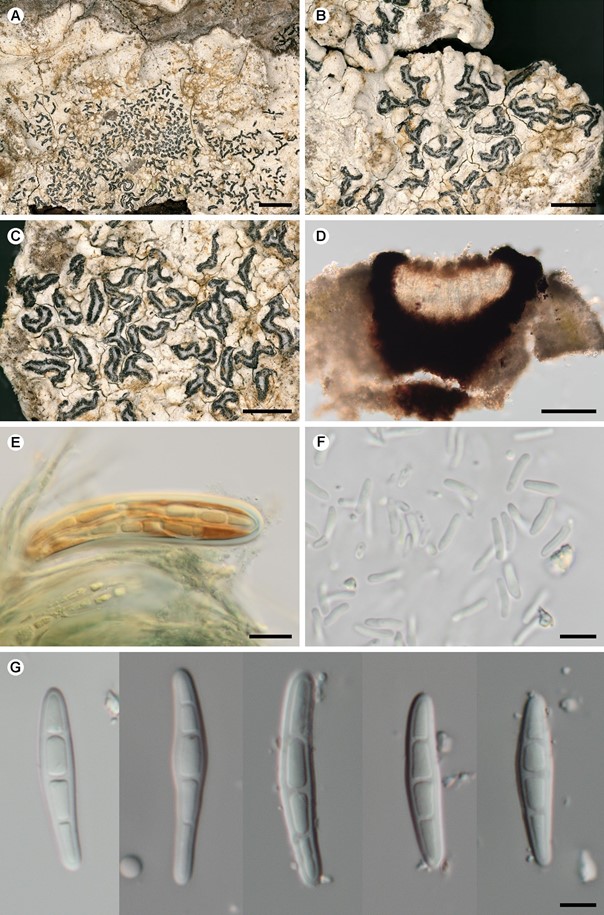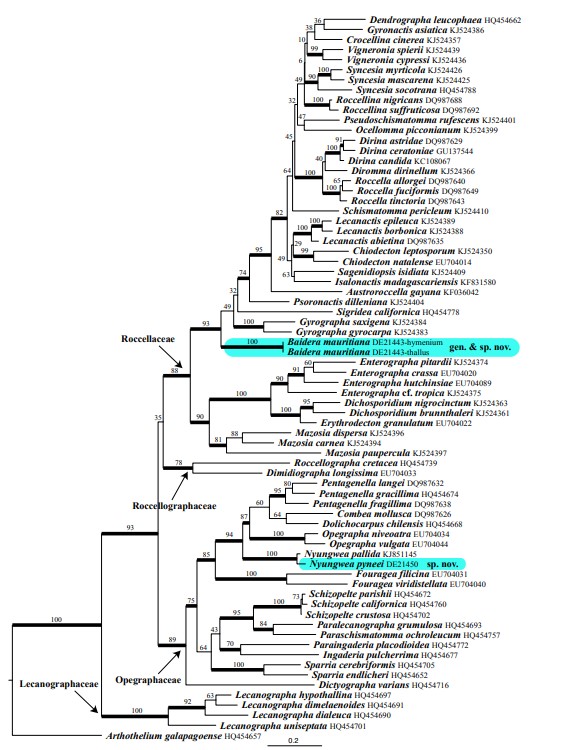Baidera mauritiana Ertz & Diederich, sp. nov. (Figs 3–4)
MycoBank number: MB 834918; Index Fungorum number: IF 834918; Facesoffungi number: FoF;
Diagnosis: The only species of Baidera is characterized by a pale greyish, almost white thallus, ascomata of 0.25–2.7 × 0.19–0.29 mm, a K+ olivaceous green excipulum and 3(–4)-septate ascospores of 25–35 × 4.5–6.0 µm.
Type: Mauritius, Pamplemousses district, Pamplemousses, Sir Seewoosagur Ramgoolam Botanical Garden, 20°06’21″S, 57°34’49″E, alt. 80 m, on bark of Mangifera, 29 Dec. 2016, Ertz 21443 (MAU – holotype, BR, herb. Diederich – iso- types).
Description. Thallus 50–280 µm thick, continuous, pale greyish, almost white, ± smooth to rough, sometimes with areas appearing bullate, rimose to areolate, esorediate or rarely with whitish soredia, non-isidiate; medulla containing crystals (1–8 µm diam.) of calcium oxalate (tested with 25% H2SO4), I+ red; hyphae hyaline, 1.5–2 µm diam., I+ orange; prothallus dark brown, 0.1–0.5 mm wide. Photobiont cells elongated, ~6–14 × 5–10 µm. Ascomata lirelliform, simple, rarely with one ramification, semi-sessile, without constricted base, straight to strongly flexuose 0.25–2.0(–2.7) × 0.19–0.29 mm, scattered or densely distributed; asco- matal margin prominent, slightly raised above the level of the hymenial disc, black, ± smooth, ± glossy; hymenial disc black, ± smooth, plane, covered by a thin layer of white pruina; excipulum 42–50 µm thick laterally, K+ olivaceous green; hypothecium 85–175 µm thick, K+ olivaceous green; hymenium not inspersed, pale yellowish to almost hyaline, 75–85 µm tall, I+ dark red; subhymenium ~10–15 µm thick, I+ pale blue in parts; epihymenium pale orange-brown, I+ pale orange to pale blue, K– (becoming almost hyaline); paraphysoids mostly simple, sometimes branched (mainly in epihymenium), 1.5–2 µm, with a slightly enlarged and pale orange-brown apical cell of 2–3 µm in diameter; asci 8-spored, 65–70 × 13–15 µm. Ascospores 3(–4)-septate, (25–)25.4–30.7(–35) × (4.5–)4.8–5.7(–6) µm, ratio L/B (4.6–)4.9–5.9(–6.4) (n = 26). Conidiomata either prominent, 0.3–1 mm diam, with a thick thallus border and pore-like to short slit-like, slightly exposed, pale to dark brown opening, or immersed; wall rather inconspicuous, ~10 µm thick, pale yellowish; conidiogenous cells ~5–8 × 1.5–2 µm; conidia straight, rarely slightly curved, 4–6 × 1.5(–2) µm. Chemistry: thallus K–, C–, KC–, PD+ distinctly yellow, UV–; psoromic (major) and three ± fatty acids of Rf 7, 10 and 17 detected by TLC (solvent B’).
Ecology and distribution. The species is known from two localities in Mauritius, where it grows on the bark of big trees in parkland conditions.
Notes. The new species is unique in having a thick pale greyish thallus containing psoromic acid, the lirelliform ascomata with a carbonized K+ olivaceous green excipulum, an exposed whitish pruinose hymenial disc, and 3-septate large ascospores lacking a gelatinous sheath. Lecanactis californica is similar to our new species by the presence of psoromic acid and 3-septate ascospores, but differs by more roundish, unbranched, wider ascomata that are constricted at the base, slightly shorter ascospores (20–28 µm), and fili- form conidia 5–6 × 1 µm (Egea & Torrente 1994). The new species is reminiscent of Lecanographa, a genus in which L. follmanii appears to be the most similar to our new species, but it differs by much narrower ascospores (3–3.5 µm wide) with a distinct gelatinous sheath. Specimens Diederich 18734, 18741 and Ertz 21486 have only pycnidia, while specimen Diederich 18246 is sorediate.
Etymology. The specific epithet refers to the occurrence in Mauritius.
Additional specimens examined. MAURITIUS. Pamplemousses: Pamplemousses, Sir Seewoosagur Ramgoolam Botanical Garden, 80 m, 20°06’21″S, 57°34’49″E, on bark of a big tree, 2016, Ertz 21486 (pycnidia only); ibid., 20.10631°S, 57.58133°E, on bark of trees, 2016, Diederich 18246 (fertile and sorediate). Moka: Réduit, State House Park, on bark, 2019, Diederich 18734, 18741, 18742 & Ertz 23312.

Figure 3. Baidera mauritiana [holotype]. A–C – thallus and ascomata; D – section of ascoma, in water; E – asci, in KI; F – conidia, in water; G – ascospores, in water. Scale bars: A = 2.5 mm; B–C = 1 mm; D = 100 µm; E = 10 µm; F–G = 5 µm. Photos: D. Ertz.

Figure 4. Phylogeny of Arthoniales based on a data set of RPB2 sequences that resulted from a RAxML analysis. Maximum likelihood bootstrap values are shown above or near internal branches. Internal branches, considered strongly supported by both the RAxML and Bayesian analyses, are represented by thicker lines. The newly sequenced samples from Mauritius are highlighted and their names followed by collecting numbers of authors, which act as specimen and sequence identifiers.
